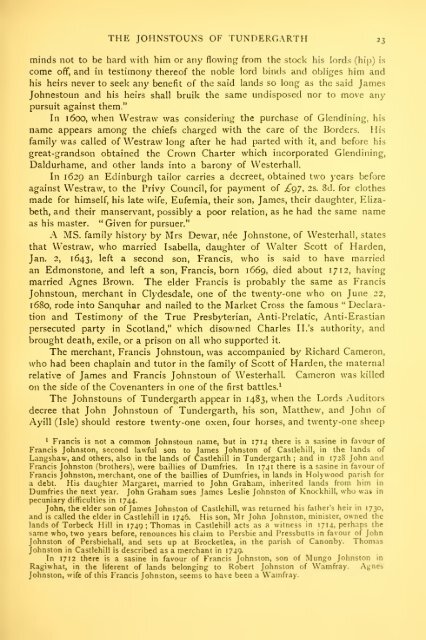History of the Johnstones, 1191-1909, with ... - Electric Scotland
History of the Johnstones, 1191-1909, with ... - Electric Scotland
History of the Johnstones, 1191-1909, with ... - Electric Scotland
You also want an ePaper? Increase the reach of your titles
YUMPU automatically turns print PDFs into web optimized ePapers that Google loves.
THE JOHNSTOUNS OF TUNDERGARTH 23<br />
minds not to be hard <strong>with</strong> him or any flowing from <strong>the</strong> stock his lords (hip) is<br />
come <strong>of</strong>f, and in testimony <strong>the</strong>re<strong>of</strong> <strong>the</strong> noble lord binds and obliges him and<br />
his heirs never to seek any benefit <strong>of</strong> <strong>the</strong> said lands so long as <strong>the</strong> said James<br />
Johnestoun and his heirs shall bruik <strong>the</strong> same undisposed nor to move any<br />
pursuit against <strong>the</strong>m."<br />
In 1600, when Westraw was considering <strong>the</strong> purchase <strong>of</strong> Glendining, his<br />
name appears among <strong>the</strong> chiefs charged <strong>with</strong> <strong>the</strong> care <strong>of</strong> <strong>the</strong> Borders. Hi.<br />
family was called <strong>of</strong> Westraw long after he had parted <strong>with</strong> it, and before his<br />
great-grandson obtained <strong>the</strong> Crown Charter which incorporated Glendining,<br />
Daldurhame, and o<strong>the</strong>r lands into a barony <strong>of</strong> Westerhall.<br />
In 1629 an Edinburgh tailor carries a decreet, obtained two years before<br />
against Westraw, to <strong>the</strong> Privy Council, for payment <strong>of</strong> £97, 2s. 8d. for clo<strong>the</strong>s<br />
made for himself, his late wife, Eufemia, <strong>the</strong>ir son, James, <strong>the</strong>ir daughter, Elizabeth,<br />
and <strong>the</strong>ir manservant, possibly a poor relation, as he had <strong>the</strong> same name<br />
as his master. "Given for pursuer."<br />
A MS. family history by Mrs Dewar, nee Johnstone, <strong>of</strong> Westerhall, states<br />
that Westraw, who married Isabella, daughter <strong>of</strong> Walter Scott <strong>of</strong> Harden,<br />
Jan. 2, 1643, left a second son, Francis, who is said to have married<br />
an Edmonstone, and left a son, Francis, born 1669, died about 1712, having<br />
married Agnes Brown. The elder Francis is probably <strong>the</strong> same as Francis<br />
Johnstoun, merchant in Clydesdale, one <strong>of</strong> <strong>the</strong> twenty-one who on June 22,<br />
1680, rode into Sanquhar and nailed to <strong>the</strong> Market Cross <strong>the</strong> famous " Declara-<br />
tion and Testimony <strong>of</strong> <strong>the</strong> True Presbyterian, Anti-Prelatic, Anti-Erastian<br />
persecuted party in <strong>Scotland</strong>," which disowned Charles II.'s authority, and<br />
brought death, exile, or a prison on all who supported it.<br />
The merchant, Francis Johnstoun, was accompanied by Richard Cameron,<br />
who had been chaplain and tutor in <strong>the</strong> family <strong>of</strong> Scott <strong>of</strong> Harden, <strong>the</strong> maternal<br />
relative <strong>of</strong> James and Francis Johnstoun <strong>of</strong> Westerhall. Cameron was killed<br />
on <strong>the</strong> side <strong>of</strong> <strong>the</strong> Covenanters in one <strong>of</strong> <strong>the</strong> first battles. 1<br />
The Johnstouns <strong>of</strong> Tundergarth appear in 1483, when <strong>the</strong> Lords Auditors<br />
decree that John Johnstoun <strong>of</strong> Tundergarth, his son, Mat<strong>the</strong>w, and John <strong>of</strong><br />
Ayill (Isle) should restore twenty-one oxen, four horses, and twenty-one sheep<br />
1 Francis is not a common Johnstoun name, but in 1714 <strong>the</strong>re is a sasine in favour <strong>of</strong><br />
Francis Johnston, second lawful son to James Johnston <strong>of</strong> Castlehill, in <strong>the</strong> lands <strong>of</strong><br />
Langshaw, and o<strong>the</strong>rs, also in <strong>the</strong> lands <strong>of</strong> Castlehill in Tundergarth ; and in 172S John and<br />
Francis Johnston (bro<strong>the</strong>rs), were baillies <strong>of</strong> Dumfries. In 1741 <strong>the</strong>re is a sasine in favour <strong>of</strong><br />
Francis Johnston, merchant, one <strong>of</strong> <strong>the</strong> baillies <strong>of</strong> Dumfries, in lands in Holywood parish for<br />
a debt. His daughter Margaret, married to John Graham, inherited lands from him in<br />
Dumfries <strong>the</strong> next year. John Graham sues James Leslie Johnston <strong>of</strong> Knockhill, who was in<br />
pecuniary difficulties in 1744.<br />
John, <strong>the</strong> elder son <strong>of</strong> James Johnston <strong>of</strong> Castlehill, was returned his fa<strong>the</strong>r's heir in 1730,<br />
and is called <strong>the</strong> elder in Castlehill in 1746. His son, Mr John Johnston, minister, owned <strong>the</strong><br />
lands <strong>of</strong> Torbeck Hill in 1749; Thomas in Castlehill acts as a witness in 1714, perhaps <strong>the</strong><br />
same who, two years before, renounces his claim to Persbie and Pressbutts in favour <strong>of</strong> John<br />
Johnston <strong>of</strong> Persbiehall, and sets up at Brocketlea, in <strong>the</strong> parish <strong>of</strong> Canonby. Thomas<br />
Johnston in Castlehill is described as a merchant in 1749.<br />
In 1712 <strong>the</strong>re is a sasine in favour <strong>of</strong> Francis Johnston, son <strong>of</strong> Mungo Johnston in<br />
Ragiwhat, in <strong>the</strong> liferent <strong>of</strong> lands belonging to Robert Johnston <strong>of</strong> Wamfray.<br />
Johnston, wife <strong>of</strong> this Francis Johnston, seems to have been a Wamfray.

















